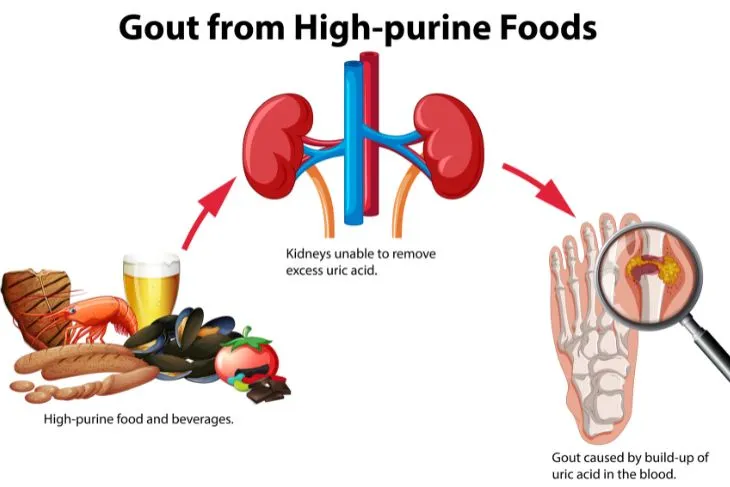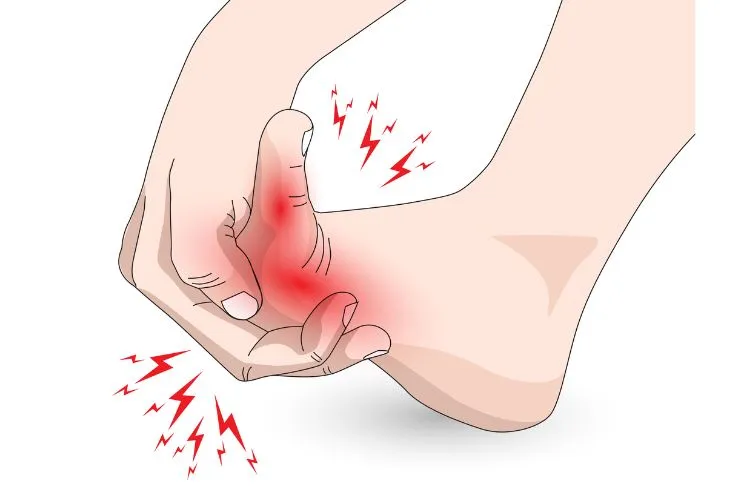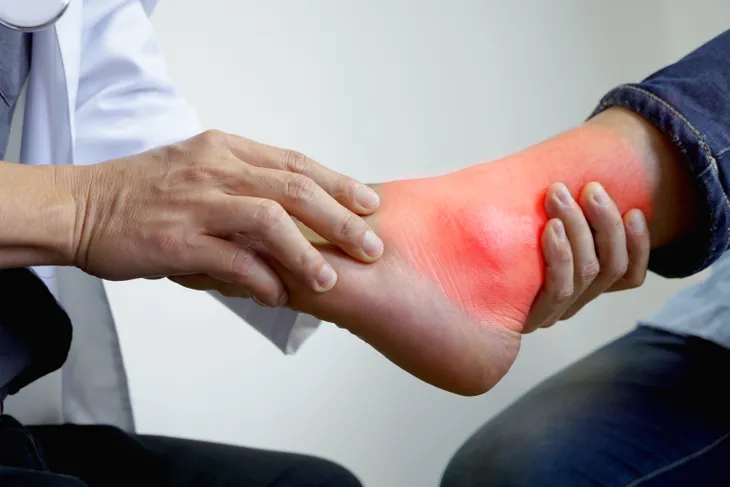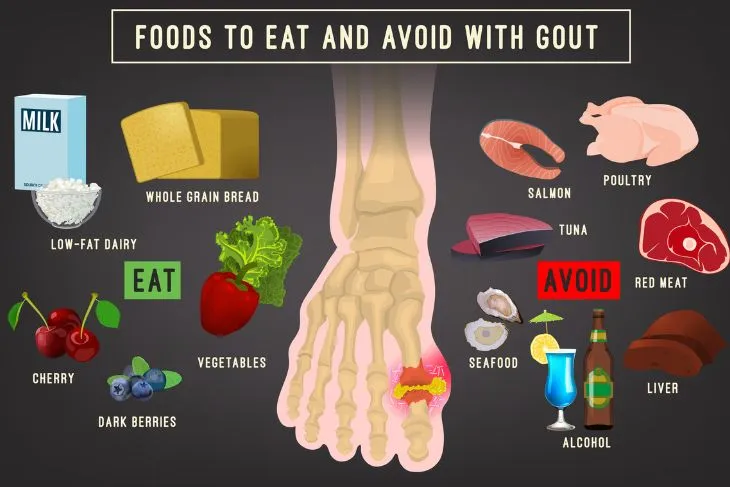- Gout is a type of inflammatory arthritis and causes joint pain, inflammation, redness, swelling, and lingering discomfort.
- There are many myths surrounding gout including who it affects, why it occurs and how serious it is.
- Other common misconceptions include how to treat or potentially cure gout and whether or not it needs treatment at all.
- This article includes the most common myths about gout and what the truth is behind them.
Gout is a form of inflammatory arthritis that usually affects the big toe, but can occur in any joint on the body. The trademark symptoms are sudden, severe attacks of pain, swelling, redness, and tenderness in one or more joints, says the Mayo Clinic. Attacks or flares usually start suddenly and last for days or weeks, followed by long periods of remission.
Unfortunately there is no cure for gout. The only form of treatment is to learn how to manage symptoms. Gout is a relatively common condition so there’s lots of information available, but also many myths and misconceptions. We’re here to debunk the most common myths about gout and reveal the truth behind them…
Gout Only Affects Men
While gout does tend to affect more young men than women, it’s not a gender-specific condition. Women can have gout. The reason they are less likely to get it is because they have lower uric acid levels, says the Mayo Clinic. However, this changes after menopause when their uric acid levels actually go up to match those of men.
This is why WebMD states that women’s likelihood of developing gout increases after they’ve gone through menopause. At this point the rate of men and women having gout becomes more even. Women won’t start showing signs and symptoms until after menopause, whereas men are more likely to develop the condition between the ages 30 and 50, notes the Mayo Clinic. Despite all this, keep in mind that gout can occur at any age.
Gout Only Affects Obese People
Not only does gout affect both genders, it affects people of all sizes too. There’s a misconception that only obese or overweight people develop gout which isn’t true. The truth is uric acid levels tend to be higher in people who are overweight, according to research published on The Rheumatologist. These higher levels of uric acid increase the risk of gout.
However, weight is not the only risk factor for gout. The Mayo Clinic also lists age, gender, family history, certain medications and medical conditions (untreated high blood pressure and chronic conditions such as diabetes, metabolic syndrome, heart and kidney disease), and recent surgery or trauma as factors that all come into play when determining whether or not a person will have gout.
Cherry Juice Cures Gout
Cherry juice is often touted as a cure or popular remedy for gout, but there’s little scientific evidence to back this up. Everyday Health does cite one small study that merely suggests eating cherries may help lower uric acid levels, the findings of this study have not been confirmed. In fact, WebMD says drinking a high-fructose corn syrup like cherry juice could even lead to a flare-up.
Instead of drinking cherry juice or eating lots of cherries, Everyday Health suggests talking to your doctor about what diet changes can be made to better manage your condition.
It’s Caused by an Unhealthy Diet
There’s no denying that diet plays a role in many facets of our health, but when it comes to being the sole and underlying cause of gout, this isn’t true. Food isn’t the only reason a person develops gout, says WebMD. There are many other factors that come into play, such as weight, genes, and even certain medications a person is taking.
Part of this myth is the assumption that people with gout can’t eat any rich foods because they are what causes it in the first place. However, rheumatologist Scott Burg, DO tells the Cleveland Clinic that if eaten in moderation, desserts and other rich foods won’t affect gout flare-ups. The key is moderation. “Rich foods might not cause flare-ups directly, but they can cause weight gain. and obesity is a major risk factor for gout attacks.”
It’s Not a Serious Disease
Even though one of the common characteristics of gout is a sharp and severe pain, it’s often thought of as a mild form of arthritis. This couldn’t be further from the truth. It’s actually one of the most painful forms of arthritis. “People describe [gout] as the worst pain of their life,” says Daniel Solomon, MD, MPH, associate professor of medicine at Harvard Medical School and a physician in the rheumatology, immunology, and allergy department at Brigham and Women’s Hospital in Boston to Everyday Health.
Not only that, it’s a very serious disease. WebMD notes that advanced cases of gout or gout that goes untreated for a long period of time can lead to joint damage, kidney stones, kidney disease, and even inflammation that can damage the heart.
People with Gout Can’t Eat Meat
Since diet can play such a large role in both managing and preventing gout, it’s not surprising that there are a lot of misconceptions around diet and this condition. One of the most common myths is that people with gout can’t eat meat. WebMD clears this one up by stating, “some meats like chicken, turkey, duck, and pork are OK in moderation, but it’s best to avoid things like beef, lamb, and game meats.”
In addition to being modest with meat consumption, the Cleveland Clinic suggests being wary of seafood like shrimp and lobster because it tends to be higher in purines.
Abstaining from Alcohol will Cure Gout
Similar to meat and rich foods, alcohol can be enjoyed in moderation. The best thing to do is cut it out. “Alcohol molecules in your body tend to increase uric acid levels, so drinking can push you over the edge and into a flare-up,” writes the Cleveland Clinic. For people who have recently been diagnosed with gout and are starting a new medication, it’s a good idea to start by cutting alcohol out entirely.
After a while, talk to your doctor and discuss if it’s okay to add a small amount back in. This may be possible as uric acid levels come down. “But even then, it’s best to avoid beer and liquor and stick to safer choices such as red wine,” says Dr. Burg to the Cleveland Clinic.
It Will Go Eventually Go Away
Gout will not go away on its own, however gout attacks will eventually subside even without treatment. Despite this, it’s very important that people with gout seek treatment to help manage their symptoms. Even though these attacks will go away, it’s only temporary. They will recur, especially if nothing is done to prevent them, warns Everyday Health.
To properly treat gout, you’ll need “medications to lower uric acid levels and reduce pain from uric acid formation in joints and other areas of the body,” writes the source. These medications are integral for gout patients as they not only help get gout attacks under control, but can also reduce the chances of them happening in the future. Everyday Health also notes that many gout patients will take uric acid lowering medications long term to keep gout at bay.
It Never Lasts Longer Than 10 Days
Gout is known for its flare-ups or attacks that strike suddenly and then subside. Most people suffer from acute attacks that last anywhere from one day to a week. This is likely where the myth stems from that a gout attack will never last longer than 10 days. This is not true.
According to Everyday Health, some people experience chronic gout episodes that carry on for long periods of time — weeks even. This can be very dangerous as it can lead to joint damage. Dr. Solomon tells the source that while these attacks last longer, the pain tends to be less severe.
Only Affects the Big Toe
Most people with gout experience the majority of their discomfort in the big toe. It seems to the be most vulnerable place, but gout can affect other joints too. It’s been known to occur in the ankles, knees, wrists, fingers, and other parts of the feet.
With that being said, Everyday Health does point out that roughly 9 out of 10 people with gout will have an attack in their big toe. The reason behind this is likely due to the pressure it gets from standing and walking, says the source.
It’s a Rare Condition
While it might not be the most talked about condition out there, it’s a relatively common one, especially for men and older adults. It’s estimated that 1-percent of Americans have gout (or at least reported it) which adds up to roughly 3-million adults at any one time, says Everyday Health. As we already mentioned, it’s most common among older men and postmenopausal women.
In addition to that, it’s the most common form of arthritis in men over 40 and according to the Arthritis Foundation, it’s the most common type of inflammatory arthritis. While it’s more common in older adults, hereditary forms of gout often affect men under 30 and tends to be much more severe, warns Everyday Health.
Diet Can Cure Gout
There’s no denying that diet plays a large role in both managing and treating gout, but on its own it’s not a cure. There is no cure for gout. When treating gout, doctors will prescribe medication that reduces pain and inflammation during an attack and lowers uric acid levels in the body.
Creakyjoints.org refers to the American College of Rheumatology which notes that people who get two or more gout attacks a year are recommended to be on medication. This is also true for people with gout tophi or those with joint damage from gout. In addition to medication, a doctor will likely suggest lifestyle changes like exercise, increase fluid intake, weight loss, and diet changes.
Avoid foods that worsen or increase the likelihood of gout attacks (i.e. red meat, French fries, sweets and alcohol). Overall, the Arthritis Foundation suggests eating healthy unprocessed foods. Focus on whole grains, fruits, veggies, nuts, and other whole unprocessed foods. Remember, diet alone cannot cure gout.















